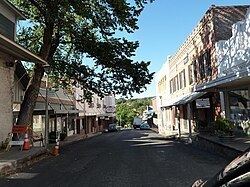Country United States ZIP codes 95249-95250 Area 21.74 km² Population 2,783 (2010) | Time zone Pacific (PST) (UTC-8) FIPS code 06-64420 Elevation 310 m Area code Area code 209 | |
 | ||
San Andreas is an unincorporated census-designated place and the county seat of Calaveras County, California. The population was 2,783 at the 2010 census, up from 2,615 at the 2000 census. Like most towns in the region, it was founded during the California Gold Rush. The town is located on State Route 49 and is registered as California Historical Landmark #252.
Contents
Map of San Andreas, CA 95249, USA
History
Settled by Mexican gold miners in 1848 and named after the Catholic parish St. Andrew, the town has been a noted mining camp since early days. The gold from the initially discovered placers gave out after a few years, but the discovery of gold in an underground river channel in 1853 revitalized the camp and it soon became a town. Mining of the channels was lucrative enough for the town to completely rebuild after fires in 1858 and 1863. The gold discovered here contributed greatly to the success of the Union during the Civil War. In 1866, San Andreas became the seat of Calaveras County. It was said to be a rendezvous location for Joaquin Murrieta. Notorious highwayman Black Bart was tried here and sent to prison.
The post office was established in 1854.
Geography
According to the United States Census Bureau, the CDP has a total area of 8.4 square miles (22 km2), of which, 99.81% is land and 0.19% is water.
Climate
According to the Köppen Climate Classification system, San Andreas has a warm-summer Mediterranean climate, abbreviated "Csa" on climate maps.
2010
The 2010 United States Census reported that San Andreas had a population of 2,783. The population density was 331.5 people per square mile (128.0/km²). The racial makeup of San Andreas was 2,453 (88.1%) White, 23 (0.8%) African American, 48 (1.7%) Native American, 28 (1.0%) Asian, 1 (0.0%) Pacific Islander, 83 (3.0%) from other races, and 147 (5.3%) from two or more races. Hispanic or Latino of any race were 255 persons (9.2%).
The Census reported that 2,595 people (93.2% of the population) lived in households, 21 (0.8%) lived in non-institutionalized group quarters, and 167 (6.0%) were institutionalized.
There were 1,146 households, out of which 314 (27.4%) had children under the age of 18 living in them, 449 (39.2%) were opposite-sex married couples living together, 156 (13.6%) had a female householder with no husband present, 66 (5.8%) had a male householder with no wife present. There were 91 (7.9%) unmarried opposite-sex partnerships, and 13 (1.1%) same-sex married couples or partnerships. 396 households (34.6%) were made up of individuals and 190 (16.6%) had someone living alone who was 65 years of age or older. The average household size was 2.26. There were 671 families (58.6% of all households); the average family size was 2.84.
The population was spread out with 585 people (21.0%) under the age of 18, 197 people (7.1%) aged 18 to 24, 589 people (21.2%) aged 25 to 44, 777 people (27.9%) aged 45 to 64, and 635 people (22.8%) who were 65 years of age or older. The median age was 45.7 years. For every 100 females there were 88.6 males. For every 100 females age 18 and over, there were 85.0 males.
There were 1,311 housing units at an average density of 156.2 per square mile (60.3/km²), of which 632 (55.1%) were owner-occupied, and 514 (44.9%) were occupied by renters. The homeowner vacancy rate was 1.9%; the rental vacancy rate was 13.3%. 1,404 people (50.4% of the population) lived in owner-occupied housing units and 1,191 people (42.8%) lived in rental housing units.
2000
As of the census of 2000, there were 2,615 people, 1,097 households, and 652 families residing in the CDP. The population density was 299.4 people per square mile (115.5/km²). There were 1,167 housing units at an average density of 133.6 per square mile (51.6/km²). The racial makeup of the CDP was 92.1% White, 0.1% Black or African American, 1.5% Native American, 0.7% Asian, 2.0% from other races, and 3.6% from two or more races. 6.4% of the population were Hispanic or Latino of any race.
There were 1,097 households out of which 28.0% had children under the age of 18 living with them, 41.9% were married couples living together, 13.8% had a female householder with no husband present, and 40.5% were non-families. 34.2% of all households were made up of individuals and 18.4% had someone living alone who was 65 years of age or older. The average household size was 2.24 and the average family size was 2.85.
In the CDP, the population was spread out with 24.2% under the age of 18, 7.6% from 18 to 24, 21.6% from 25 to 44, 22.6% from 45 to 64, and 23.9% who were 65 years of age or older. The median age was 43 years. For every 100 females there were 89.8 males. For every 100 females age 18 and over, there were 81.9 males.
The median income for a household in the CDP was $32,500, and the median income for a family was $37,969. Males had a median income of $39,583 versus $24,500 for females. The per capita income for the CDP was $16,813. About 14.4% of families and 14.8% of the population were below the poverty line, including 19.5% of those under age 18 and 8.9% of those age 65 or over.
Politics
In the state legislature, San Andreas is in the 8th Senate District, represented by Republican Tom Berryhill, and the 5th Assembly District, represented by Republican Frank Bigelow. Federally, San Andreas is in California's 4th congressional district, represented by Republican Tom McClintock.
